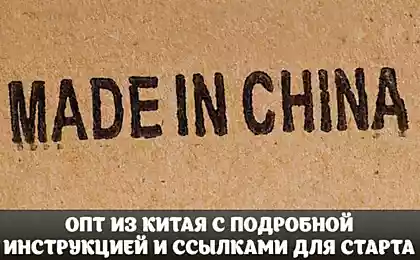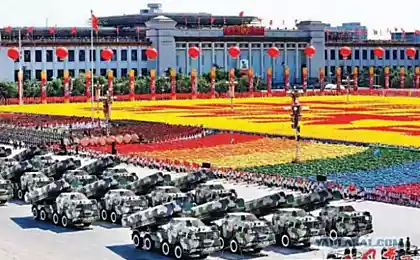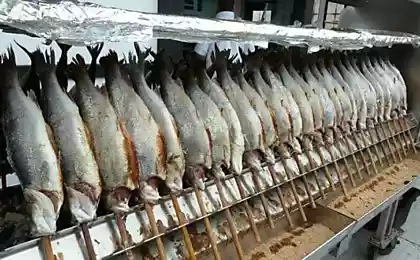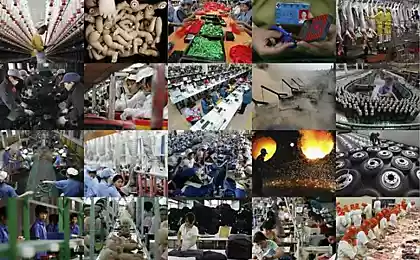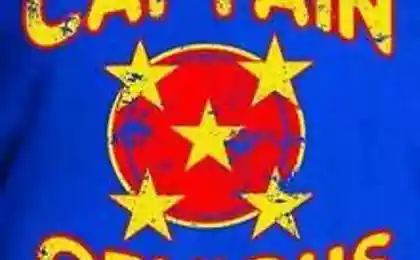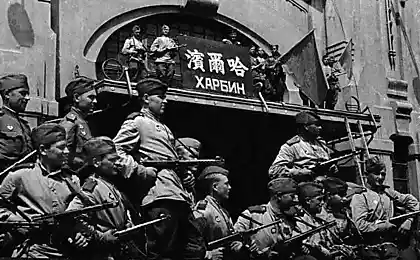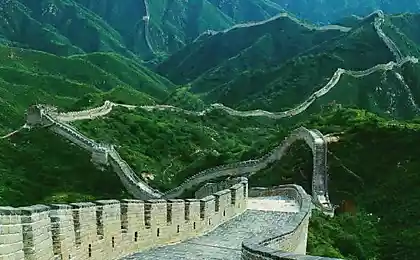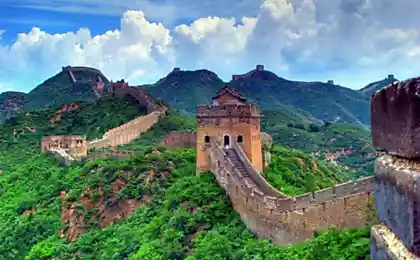816
Superproject China
1. In the early 1990s, the average speed of passenger rail in China fell to 50 km / h. The inhabitants of the vast country, begins the way to a brighter future of semi-capitalist, have been actively change to personal cars, motorcycles, mopeds and bicycles. After just 20 years, and thanks to the hundreds of billions of dollars of public investment in China appeared a dense network of high-speed railways, which is used daily by millions of people. Onliner.by tells how the Chinese were transferred to the cartage of "bullet-train».
Already in the early 1990s created during the XX century, China's railway network is no longer cope with the rapidly growing service economy, in fact, becoming a factor hindering its development. The average speed of transport by rail by 1993 has fallen below 50 km / h. Special alternative while for freight trains does not appear, but the passengers began to actively lose customers: Chinese began to be happy to use the services of highways and airlines.
56 photo + some text

2.

3. To honor the country's leadership, the scope and the possible consequences of the urgent problems it is aware of and evaluate quickly enough. Designing a network of high-speed rail lines began in the 1990s, both were actively working to improve the speed of traffic on the existing lines. There were mass electrification of railways, construction of new bridges and tunnels, to lay additional ways - some very lively areas become chetyrehputnymi: slow cargo movement separated from the passenger.

4. From 1997 to 2004, about 7,700 kilometers of the Chinese railways were reconstructed, trains were able to move them at speeds up to 160 km / h.
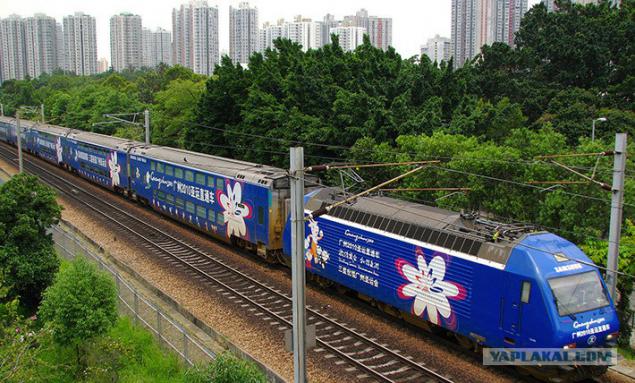
5.
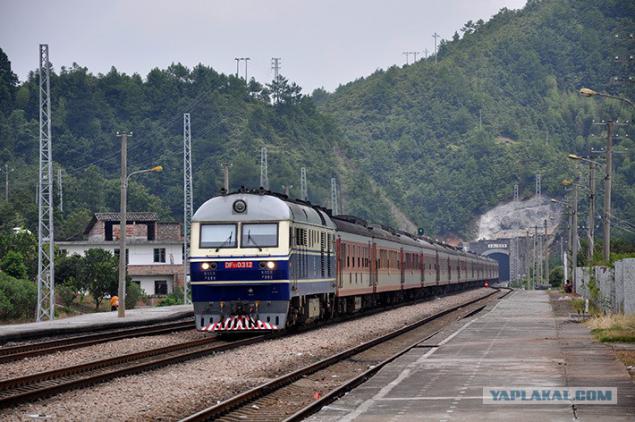
6. However, it was only the first and not the most expensive phase of the Chinese "project of the century." In the late 1990s, the Chinese government started construction of railways fundamentally different types - dedicated double-track high-speed lines designed exclusively for passenger traffic, and allows you to accelerate the rolling stock up to 350 km / h.
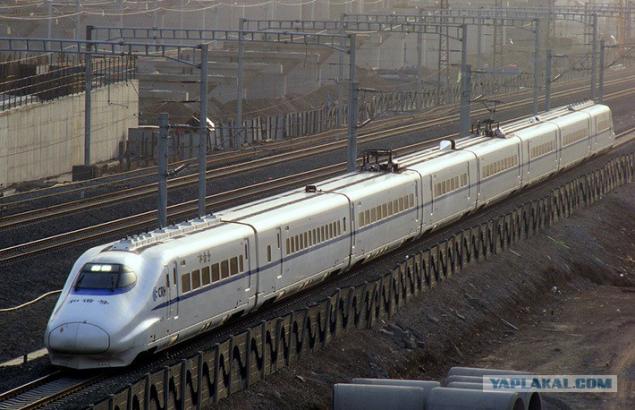
7.
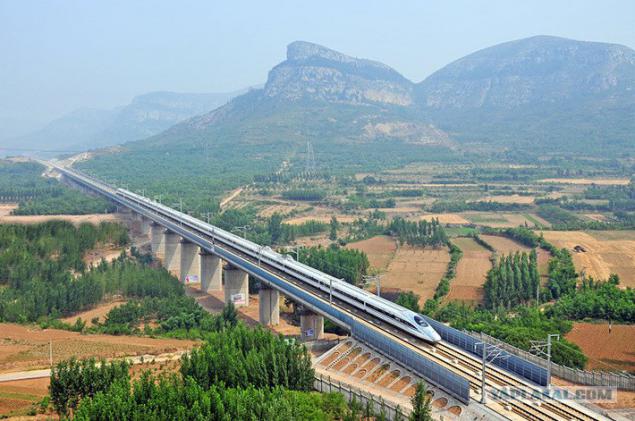
8. The first-born was the Qinhuangdao-Shenyang High-Speed Railway, named for the first syllables of the two largest in the north-eastern part of the country's cities, it connects Qinhuangdao and Shenyang. For four years (1999-2003), and $ 2 billion in China in parallel oldest and extremely busy highway Beijing - Harbin were built 405 kilometers of double track and electrified roads, will allow to organize a high-speed passenger traffic (initially - 200 km / h, in 2013 - 300 km / h) and significantly relieve the adjacent road veteran.

9.
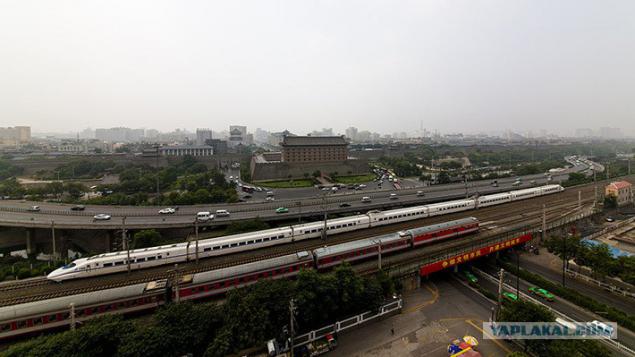
10. Beginning with the 11th Five-Year Plan (2006-2010), the construction of high-speed rail is much more active. In the framework of the state program on their construction was based on the formula of "4 + 4". Across the country were laid eight new main corridors with a total length of 12 thousand. Kilometers of four-axis "north - south" and a four-axis "East - West". The new high-speed line was originally created by autonomous railways built before, and intended solely for passenger traffic.
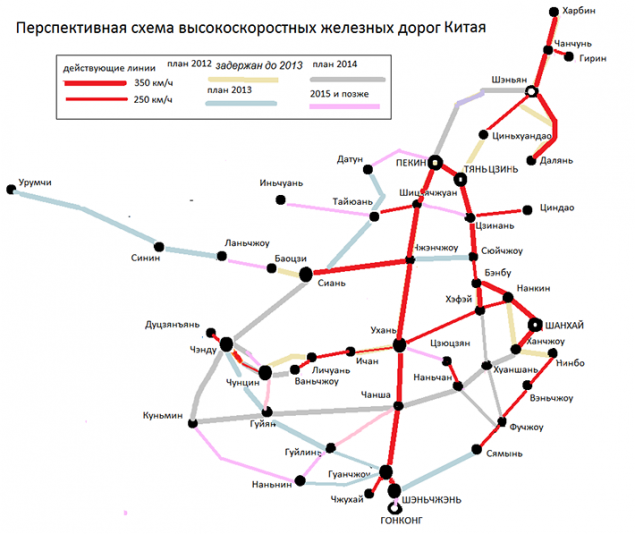
11. New lines with a speed of up to 350 km / h were to interconnect the major cities of the country and form a single network had not yet seen the world scale: the road Beijing - Harbin (1700 km), the Beijing - Shanghai (1433 km), Beijing - Hong Kong (2230 km), Shanghai - Chengdu (2,078 km), Shanghai - Kunming (1495 km) and numerous other minor branches. Striking just the fact that a large part of this great work was carried out in just 8-10 years.
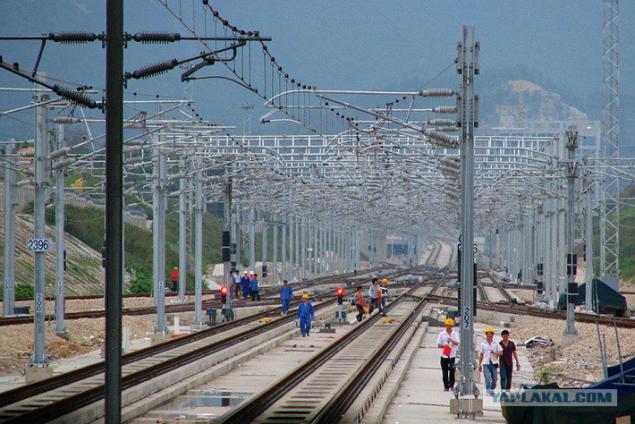
12.

13. The capital of the country combined with a major northern Chinese metropolis Harbin (a separate branch to the port of Dalian - former Russian Far town) for only 7 years (2007-2014). High-speed lines in nearly 1, 5 thousand. Kilometers between Beijing and Shanghai finished in 4 (!) Years (2008-2012). The most important "vertical" the corridor from Beijing to Hong Kong (via Guangzhou and Shenzhen), whose construction began in 2005, should open in 2016, with nearly all of the 2200 km long road has already been built - "train-bullet" go to the next to Hong Kong Shenzhen.
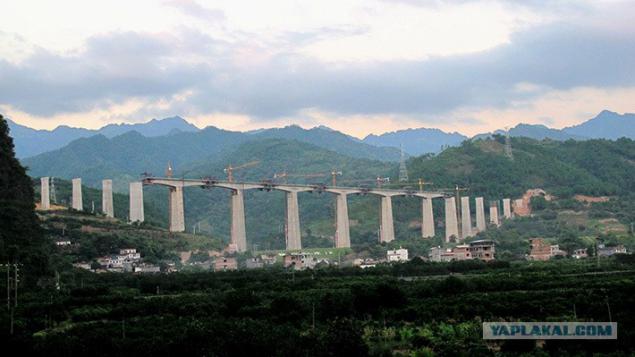
14.
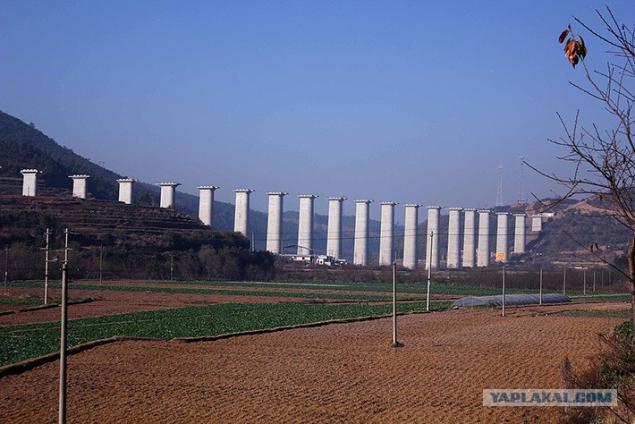
15. On the cost of traditional Chinese government pays special attention. Experts estimate that over 11 five-year plan (2006-2010) only in the high-speed line Chinese state banks and the Ministry of Railways have invested about $ 150 billion, and for the 12th Five-Year Plan (2011-2015) for the same purpose will spend another $ 430 billion - an astronomical amount for which you can buy at the root of the entire economy of other prosperous Central European countries.

16.

17. How mastered such huge budgets? For high-speed highways (SCM) imposed very stringent engineering requirements. They need special welded rail web and the absence of intersections with other roads and railways. In this regard, almost all of China's high-speed rail built on huge longest viaduct columns which sometimes go up to 80 meters depth - technology they have to rely on the bedrock.
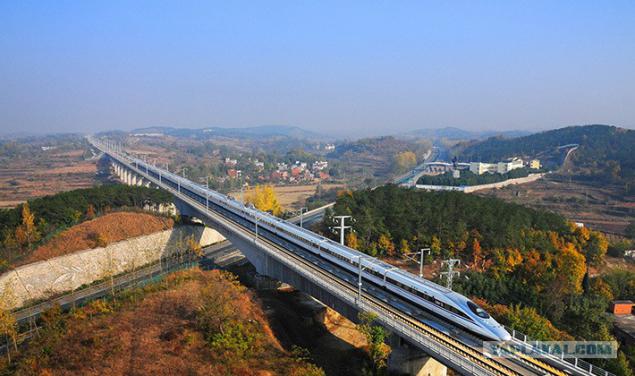
18. These viaducts are essentially bridges, overpasses, and thanks to them the primacy belongs to China in the top of the longest bridges in the world. Danyang-Kunshan Grand Bridge, part of the high-speed rail Beijing - Shanghai with its 165-km long (of which 9 kilometers laid directly over Yangcheng Lake) - the absolute world leader.
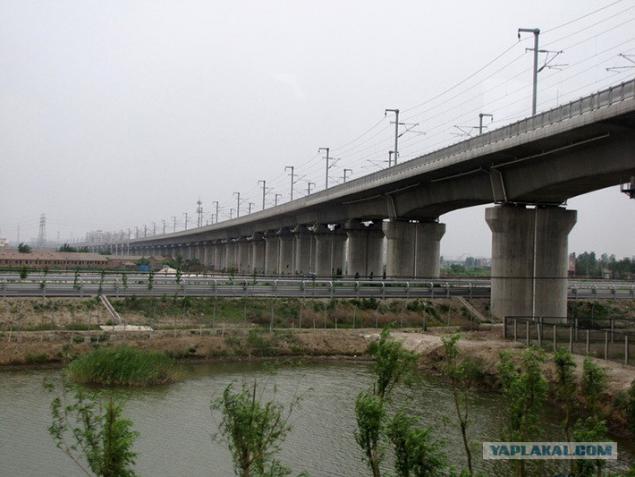
19.
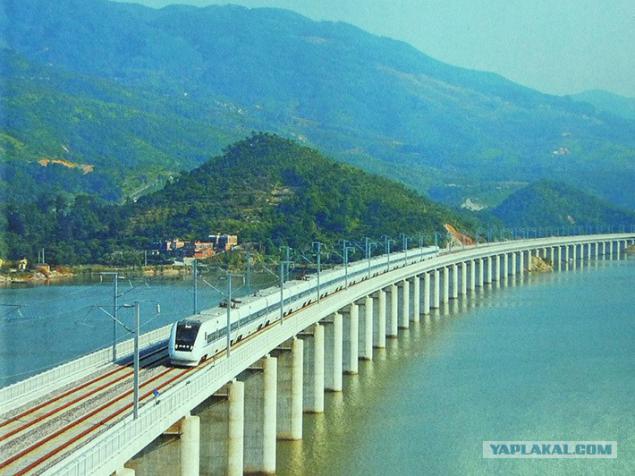
20. In second place - Tianjin Grand Bridge on the same line. Its length is 114 kilometers - almost the entire distance between Beijing and Tianjin.
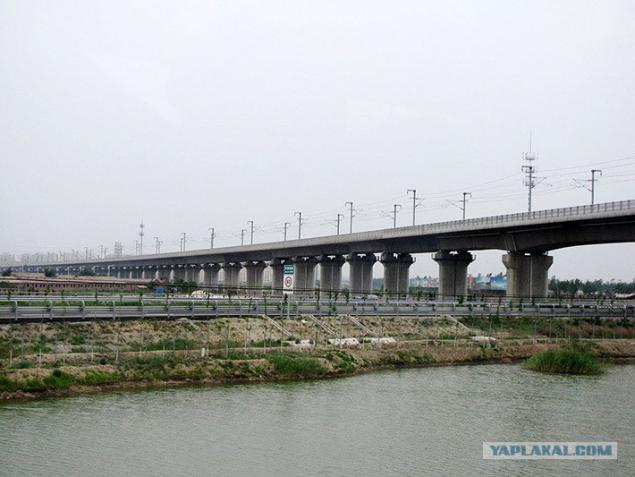
21.
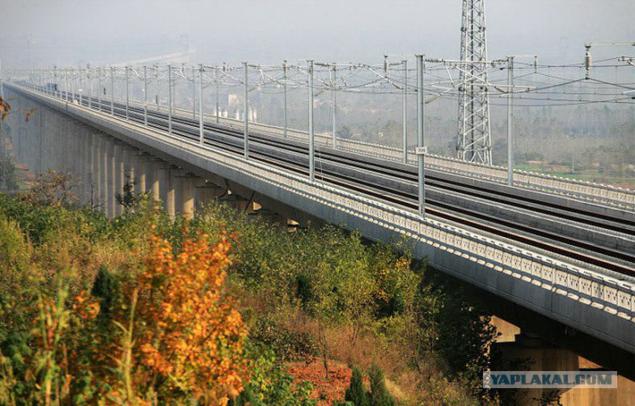
22. Rolling stock for the first high-speed roads in China supplying proven manufacturers from Europe, North America and Japan: Bombardier, Alstom, Siemens, Kawasaki. However, a prerequisite for obtaining their multibillion-dollar contracts (number of compounds supplied in the thousands) of China was the subsequent transfer of production technology and train its localization in China.

23.
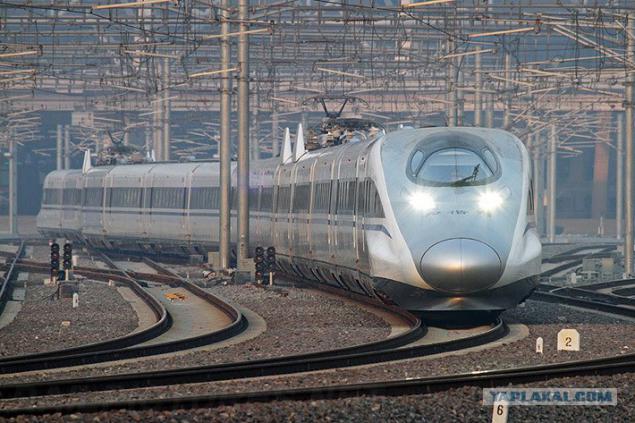
24. Operation "How to get overseas advanced technologies and not to spend money on them afterwards, leaving them in the country" was implemented by the Ministry of Railways of China is extremely elegant. Currently, the production of all rolling stock for high-speed lines, including the already fully developed by Chinese engineers, carried out at the local enterprises. Moreover, this technology products «Made in China» already exported to various countries of the world.
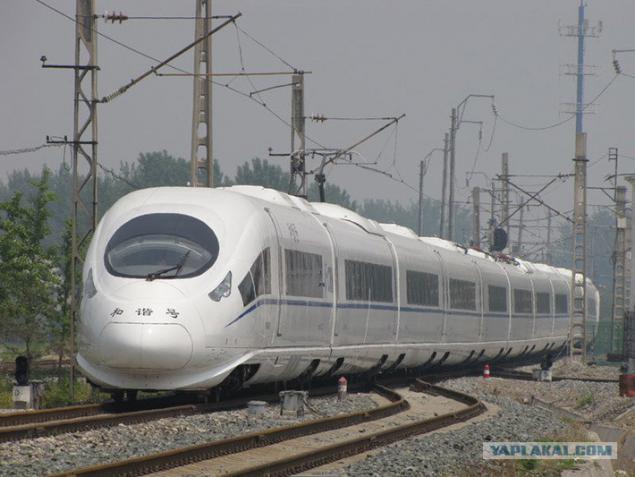
25.
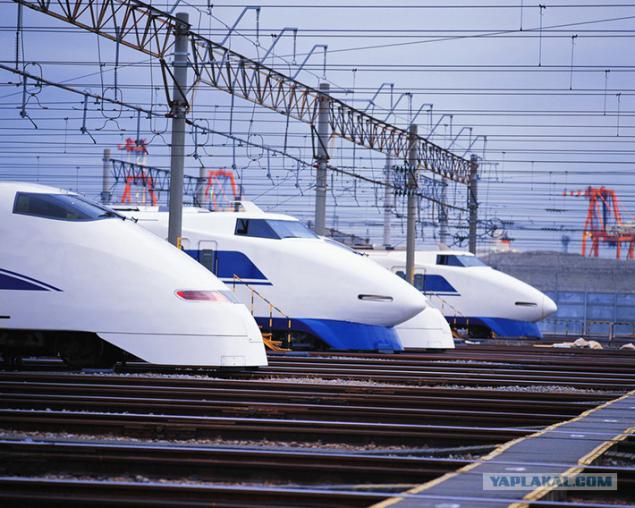
26. In parallel with the construction of its own high-speed rail in China unfolded the construction of new stations and for them. On the outskirts of almost all the major cities in the country were enormous complexes, often designed by global architectural stars of the first magnitude. Here was the firstborn Station, built in 1996 for Asia's largest railway station "Beijing-West." The enormous size of the building in the national style, serves not only high speed but also the traditional trains, at a cost of $ 750 million.
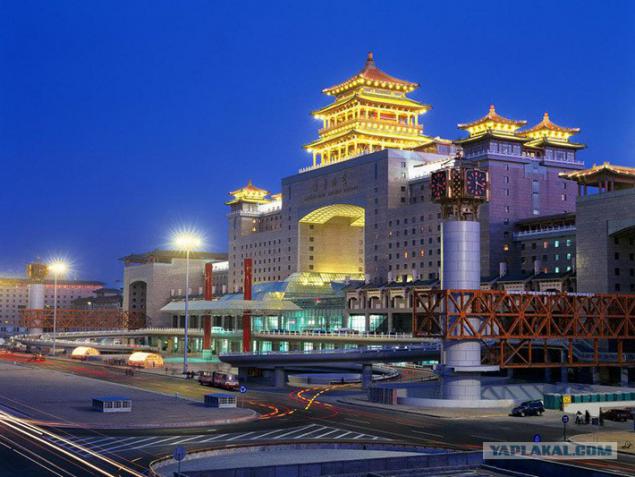
27. Subsequently, national motives in the design of the new station complexes continued to be actively used, but in a much more modern interpretation of the trendy glass and steel. It remained unchanged and the grand scale of these structures. Here are just a few examples of railway stations, built in China in recent years.
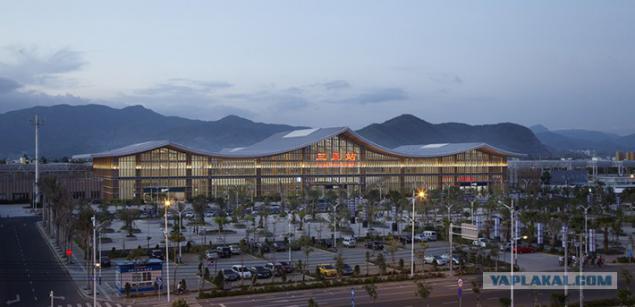
28. Tianjin West
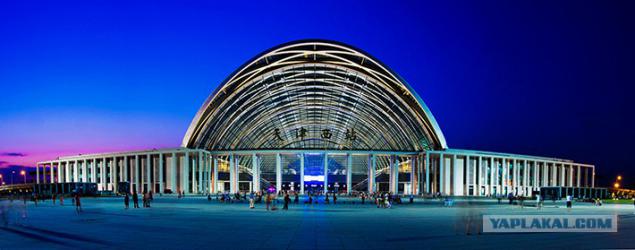
29. Ningbo South
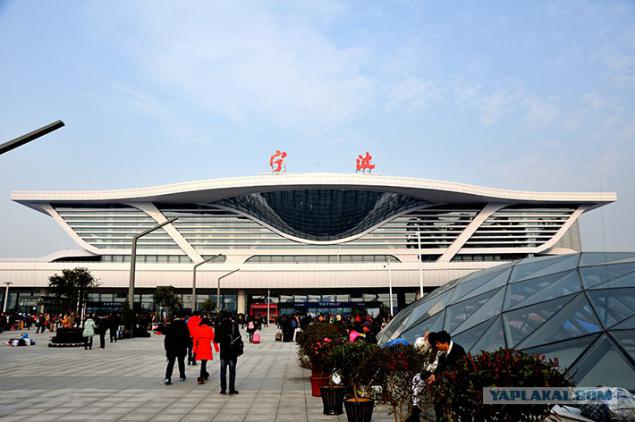
Source:
Already in the early 1990s created during the XX century, China's railway network is no longer cope with the rapidly growing service economy, in fact, becoming a factor hindering its development. The average speed of transport by rail by 1993 has fallen below 50 km / h. Special alternative while for freight trains does not appear, but the passengers began to actively lose customers: Chinese began to be happy to use the services of highways and airlines.
56 photo + some text

2.

3. To honor the country's leadership, the scope and the possible consequences of the urgent problems it is aware of and evaluate quickly enough. Designing a network of high-speed rail lines began in the 1990s, both were actively working to improve the speed of traffic on the existing lines. There were mass electrification of railways, construction of new bridges and tunnels, to lay additional ways - some very lively areas become chetyrehputnymi: slow cargo movement separated from the passenger.

4. From 1997 to 2004, about 7,700 kilometers of the Chinese railways were reconstructed, trains were able to move them at speeds up to 160 km / h.

5.

6. However, it was only the first and not the most expensive phase of the Chinese "project of the century." In the late 1990s, the Chinese government started construction of railways fundamentally different types - dedicated double-track high-speed lines designed exclusively for passenger traffic, and allows you to accelerate the rolling stock up to 350 km / h.

7.

8. The first-born was the Qinhuangdao-Shenyang High-Speed Railway, named for the first syllables of the two largest in the north-eastern part of the country's cities, it connects Qinhuangdao and Shenyang. For four years (1999-2003), and $ 2 billion in China in parallel oldest and extremely busy highway Beijing - Harbin were built 405 kilometers of double track and electrified roads, will allow to organize a high-speed passenger traffic (initially - 200 km / h, in 2013 - 300 km / h) and significantly relieve the adjacent road veteran.

9.

10. Beginning with the 11th Five-Year Plan (2006-2010), the construction of high-speed rail is much more active. In the framework of the state program on their construction was based on the formula of "4 + 4". Across the country were laid eight new main corridors with a total length of 12 thousand. Kilometers of four-axis "north - south" and a four-axis "East - West". The new high-speed line was originally created by autonomous railways built before, and intended solely for passenger traffic.

11. New lines with a speed of up to 350 km / h were to interconnect the major cities of the country and form a single network had not yet seen the world scale: the road Beijing - Harbin (1700 km), the Beijing - Shanghai (1433 km), Beijing - Hong Kong (2230 km), Shanghai - Chengdu (2,078 km), Shanghai - Kunming (1495 km) and numerous other minor branches. Striking just the fact that a large part of this great work was carried out in just 8-10 years.

12.

13. The capital of the country combined with a major northern Chinese metropolis Harbin (a separate branch to the port of Dalian - former Russian Far town) for only 7 years (2007-2014). High-speed lines in nearly 1, 5 thousand. Kilometers between Beijing and Shanghai finished in 4 (!) Years (2008-2012). The most important "vertical" the corridor from Beijing to Hong Kong (via Guangzhou and Shenzhen), whose construction began in 2005, should open in 2016, with nearly all of the 2200 km long road has already been built - "train-bullet" go to the next to Hong Kong Shenzhen.

14.

15. On the cost of traditional Chinese government pays special attention. Experts estimate that over 11 five-year plan (2006-2010) only in the high-speed line Chinese state banks and the Ministry of Railways have invested about $ 150 billion, and for the 12th Five-Year Plan (2011-2015) for the same purpose will spend another $ 430 billion - an astronomical amount for which you can buy at the root of the entire economy of other prosperous Central European countries.

16.

17. How mastered such huge budgets? For high-speed highways (SCM) imposed very stringent engineering requirements. They need special welded rail web and the absence of intersections with other roads and railways. In this regard, almost all of China's high-speed rail built on huge longest viaduct columns which sometimes go up to 80 meters depth - technology they have to rely on the bedrock.

18. These viaducts are essentially bridges, overpasses, and thanks to them the primacy belongs to China in the top of the longest bridges in the world. Danyang-Kunshan Grand Bridge, part of the high-speed rail Beijing - Shanghai with its 165-km long (of which 9 kilometers laid directly over Yangcheng Lake) - the absolute world leader.

19.

20. In second place - Tianjin Grand Bridge on the same line. Its length is 114 kilometers - almost the entire distance between Beijing and Tianjin.

21.

22. Rolling stock for the first high-speed roads in China supplying proven manufacturers from Europe, North America and Japan: Bombardier, Alstom, Siemens, Kawasaki. However, a prerequisite for obtaining their multibillion-dollar contracts (number of compounds supplied in the thousands) of China was the subsequent transfer of production technology and train its localization in China.

23.

24. Operation "How to get overseas advanced technologies and not to spend money on them afterwards, leaving them in the country" was implemented by the Ministry of Railways of China is extremely elegant. Currently, the production of all rolling stock for high-speed lines, including the already fully developed by Chinese engineers, carried out at the local enterprises. Moreover, this technology products «Made in China» already exported to various countries of the world.

25.

26. In parallel with the construction of its own high-speed rail in China unfolded the construction of new stations and for them. On the outskirts of almost all the major cities in the country were enormous complexes, often designed by global architectural stars of the first magnitude. Here was the firstborn Station, built in 1996 for Asia's largest railway station "Beijing-West." The enormous size of the building in the national style, serves not only high speed but also the traditional trains, at a cost of $ 750 million.

27. Subsequently, national motives in the design of the new station complexes continued to be actively used, but in a much more modern interpretation of the trendy glass and steel. It remained unchanged and the grand scale of these structures. Here are just a few examples of railway stations, built in China in recent years.

28. Tianjin West

29. Ningbo South

Source:
